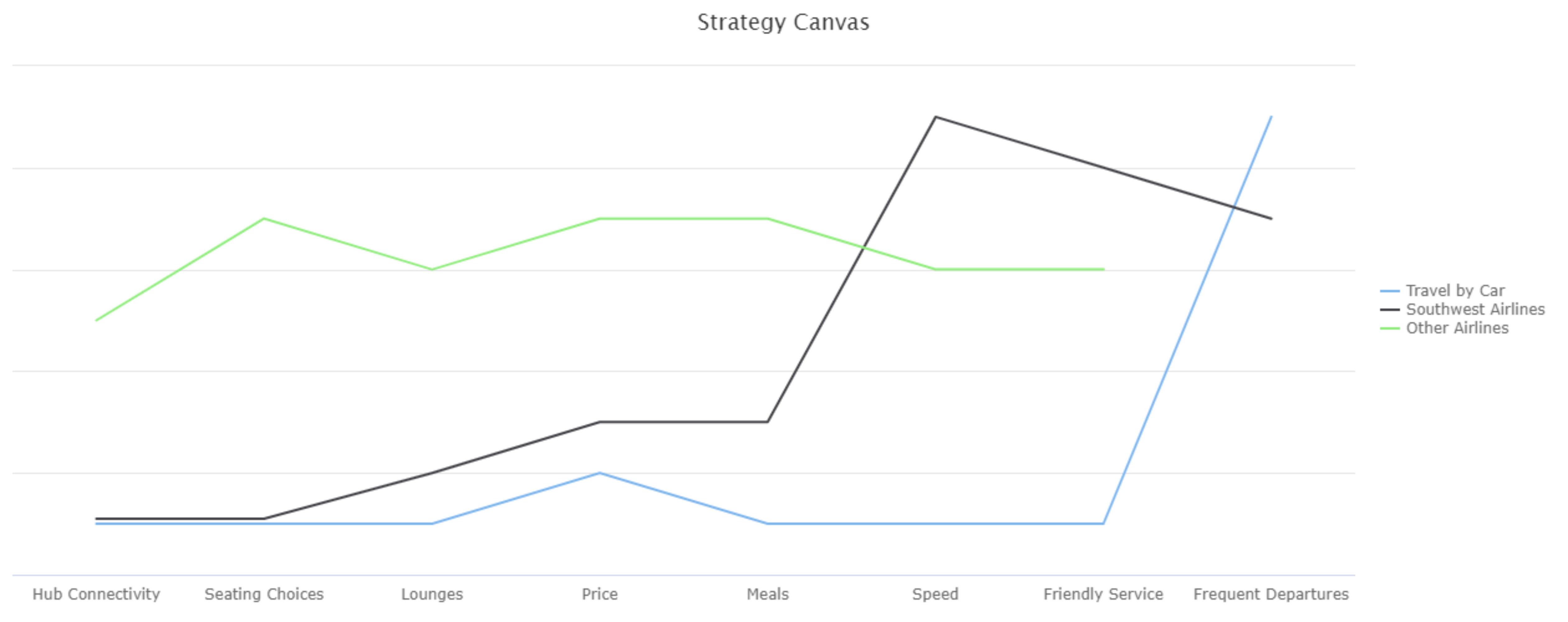 Why should you analyse the competition?
Why should you analyse the competition?
Shouldn't we just focus on our own business and customers and not worry about the competition?
We hear this question all the time. Our answer is always the same:- why wouldn't you do both?
After all, we're looking for every advantage we can find. So why would we leave any stone unturned?
Business strategy is inherently competitive. We compete for our customers' business, we compete for access to talent and resources. So it makes sense that competitor analysis plays a central role in our strategy.
In this blog post, we'll explore competitor analysis in more detail, and how you can use StratNavApp.com to stay on top of your competitor analysis.
Examples of competitor analysis
Competitor analysis has been at the heart of many breakthrough strategies (often in combination with other forms of strategic analysis).
For example:
- Before entering the smartphone market with the iPhone in 2007, Apple conducted a meticulous analysis of existing mobile phones, predominantly dominated by companies like Nikia and Blackberry. Apple identified that user experience, design and integration with other devices were areas where competitors lagged. Apple revolutionised the smartphone market by focusing on these areas.
- Tesla's strategy in the automotive sector was shaped by understanding the limitations of existing car manufacturers in the electric vehicle (EV) space. They noticed that most competitors were focused on hybrid models, leaving a gap for long-range, high-performance EVs. Tesla's disruption of the EV market has forced other manufacturers to accelerate their own EV programmes.
- Dyson's success in the household appliance market was based on analysing existing products and identifying their flaws. One example was the loss of suction in traditional bagged vacuum cleaner designs. Dyson's bagless vacuum cleaner addressed this gap and revolutionised the market.
How to do competitor analysis
Follow our simple process for staying ahead of the competition:
Identify your competitors and competitor categories
The first step in a competitor analysis is to ensure you've identified exactly who all of your competitors and competitor categories are.
When thinking about competitors, don't limit yourself to organisations that offer the same products and services as your organisation does. There may be none.
Instead, focus on all the businesses that solve the same problem your organisation solves for your target customers. Also, don't forget that you are competing against your customers' ability to solve the problem themselves, or not at all!
(Organisations that offer the same products and services are known as 'direct competitors'. Organisations that solve the same problems for your target customers with different products and services are called 'indirect competitors'.)
In StratNavApp.com:
- A competitor is an individual organisation, like ASDA or Tesco.
- A competitor category could be something like supermarkets or local restaurants.
- StratNavApp.com allows you to link individual competitors to competitor categories. (See also: How to link a Competitor to a Competitor Category.)
- A competitor category could also be a non-commercial alternative, like 'home-grown vegetables'.
Both Competitors and Competitor Categories have names and descriptions. Descriptions can be used to provide:
- Additional information such as strategic focus, unique selling proposition (USP), specific target customers, and relative strengths and weaknesses. (In fact, if you want, you can fire up a different project in StratNavApp.com and do a complete strategic analysis of a competitor. Then use the 'copy page link to clipboard' option on the main menu and past the link to that project into your description field.)
- Market data like market share, brand recognition, marketing strategies, channels and campaigns, and distribution channels.
- Financial performance data, like historic revenue, profit margins, growth rates and partnerships and acquisitions/divestments. (This information can often be sourced from financial reports.)
Competitors are a type of stakeholder. Competitors are stakeholders of type Organisation, whilst Competitor Categories are stakeholders of type Group. So for each of these two types of stakeholders records, you can specify the type. If you change these away from Competitor, or Competitor Category, then they become other types of Organisations or Groups and the system functionality that applies to them will change.
You can also use customer interviews, trade press and market reports to help you to identify competitors.
Using AI to identify competitors and categories
You can ask StratNavApp.com's AI-powered #StratBot to identify competitors and competitor categories for you.
How well it does this will depend on:
- How much information you've provided to the system. For example, describing the organisation's business model using the Business Model Canvas will help significantly.
- How well known the organisation is. The AI will likely know more about well-known brands like Apple and Amazon than it will about a small and recently opened neighbourhood restaurant. But don't be put off - the AI will still work well if you've provided enough information (see step above).
Identify the factors of competition
The factors of competition are the factors your customers consider when choosing between you and your products and services, and the alternatives available to them.
Typical factors include things like price, convenience, quality etc. But it helps if you can identify criteria which are even more specific to your customers and their Jobs-to-be-Done.
Don't only look for factors which distinguish between existing market offerings. Look for unmet needs which, when presented as factors, would cause customers to choose your offering.
Also, consider the specific needs of profitable market niches.
Using AI to identify competitive factors
You can ask StratNavApp.com's AI-powered #StratBot to identify competitive factors for you, based on all the other information you've provided to the system.
See also: Understanding Competitive Factors.
Map your business versus your competitors on a Strategy Canvas
 The Strategy Canvas show your Competitors, Competitor Categories and Competitive Factors in a visual format. This helps you to more clearly differentiate your business from the alternatives available to your customers.
The Strategy Canvas show your Competitors, Competitor Categories and Competitive Factors in a visual format. This helps you to more clearly differentiate your business from the alternatives available to your customers.
Remember, the more differentiated your business is, the easier it is to cut through the noise to attract and serve your customers, and the more easily you will be able to get a fair price for your products and services.
There are three ways you can update your Strategy Canvas:
- Drag and drop the lines on the Strategy Canvas to create the shapes you want.
- Click on any competitor or competitor category and set its competitive strength for each competitive factor using the sliders. You can also enter an explanation of your rating in the text box below.
- Click on any competitive factor and set the competitive strength for each competitor or competitor category using the sliders. Again, you can also enter an explanation of your rating in the text box below.
Stay up to date with your customers' competitive moves
It's important to continue to gather competitive intelligence on an ongoing basis. After all, we never know where our competitors might do something disruptive.
You can use StratNavApp.com to keep updated with your competitors using our newshound. Simply click the news icon to the right of the competitor's name on the competitor detail screen.
This will automatically run a Google News search on that competitor. You can click through to read any stories it finds.
You can also 'clip' any interesting news you find directly back to the competitor record in StratNavApp.com with our handy bookmarklet.
Competitive intelligence is about gathering and analysing data on your competitors' strategies, strengths, and weaknesses. With StratNavApp.com, you can effectively collect and analyse this intelligence to anticipate market shifts, identify emerging trends, and make informed strategic decisions. By leveraging competitive intelligence, you position your business not just to respond to competitors, but to proactively shape your marketing strategy.
Remember to adjust your Strategy Canvas as your competitors manoeuvre.
Link competitor analysis to strategic insights
You can link competitors, competitor categories and competitive factors to strategic Insights and other elements of your strategy in StratNavApp.com to ensure internal consistency in your strategy, and to highlight the impacts of any changes and updates.
Competitor Analysis for Startups
Many people argue that competitor analysis is not relevant for innovative startups because they are breaking the mold and creating something new. When Amazon started, there was no one else selling books online. When Netflix started, there was no one else renting DVDs by mail.
But that is the wrong way to look at competition.
Our competitors are not just those who are doing the same thing that we are. Our competitors are anyone who solves the same problem for our customers as we do.
People were buying books and renting DVDs long before Amazon and Netflix came onto the scene. But Amazon and Netflix found a better way to do it that enough customers preferred.
Remember, we're not analysing our competitors to work out how to copy them. We're doing it to make sure our offering will be sufficiently different from and better than what is already available elsewhere.
Continually ask: how is your business materially different from and better than the competition?
See also:
- Introductory Video Course: Chapter 7: Competitor Analysis and Assessing Progress
